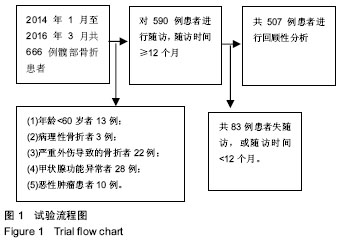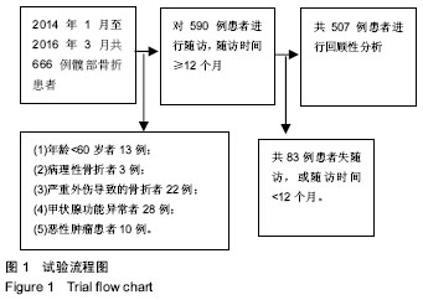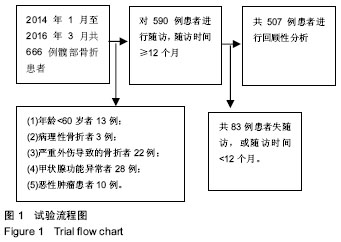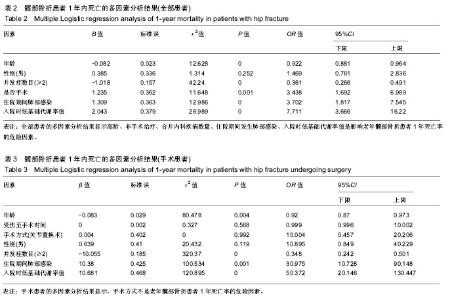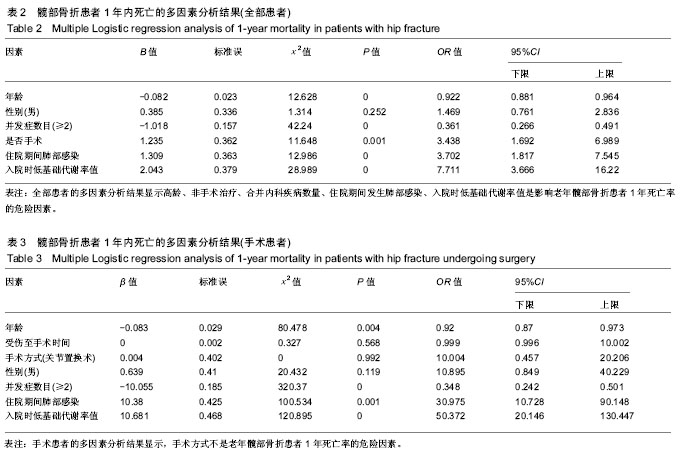| [1] Cooper C, Cole ZA, Holroyd CR, et al. Secular trends in the incidence of hip and other osteoporotic fractures. Osteoporos Int. 2011;22(5):1277.[2] Xia WB, He SL, Xu L, et al. Rapidly increasing rates of hip fracture in Beijing, China. J Bone Miner Res. 2012;27(1):125-129.[3] Torpilliesi T, Bellelli G, Morghen S, et al. Outcomes of nonagenarian patients after rehabilitation following hip fracture surgery. J Am Med Dir Assoc. 2012;13(1):1-5.[4] Kayatas K, Sahin G, Tepe M, et al. Acute kidney injury in the elderly hospitalized patients. Ren Fail. 2014;36(8):1273-1277.[5] Lystad RP, Cameron CM, Mitchell RJ. Mortality risk among older Australians hospitalised with hip fracture: a population-based matched cohort study. Arch Osteoporos. 2017;12(1):67.[6] 王培文,李毅中,林金矿,等.脆性髋部骨折的近期死亡率及相关危险因素研究[J].中华骨科杂志,2014,34(7):730-735.[7] 石忠琪.老年髋部骨折的诊断与治疗[J].医学综述, 2008,14(10): 1520-1522.[8] Kannegaard PN, Van dMS, Eiken P, et al. Excess mortality in men compared with women following a hip fracture. National analysis of comedications, comorbidity and survival. Age Ageing. 2010; 39(2):203.[9] Carretta E, Bochicchio V, Rucci P, et al. Hip fracture: effectiveness of early surgery to prevent 30-day mortality. Int Orthop.2011;35(3): 419-24.[10] Chatterton BD, Moores TS, Ahmad S, et al. Cause of death and factors associated with early in-hospital mortality after hip fracture. Bone Joint J. 2015;97-B(2):246.[11] Cha YH, Ha YC, Yoo JI, et al. Effect of causes of surgical delay on early and late mortality in patients with proximal hip fracture. Arch Orthop Trauma Surg. 2017;137(5):625-630.[12] Wu LC, Chou MY, Liang CK, et al. Factors affecting one-year mortality of elderly patients after surgery for hip fracture. Int J Gerontol. 2016;10(4):207-211.[13] Karademir G, Bilgin Y, Er?en A, et al. Hip fractures in patients older than 75 years old: Retrospective analysis for prognostic factors. Int J Surg. 2015;24(Pt A):101-104.[14] Ercin E, Bilgili MG, Sari C, et al. Risk factors for mortality in geriatric hip fractures: a compressional study of different surgical procedures in 785 consecutive patients. Eur J Orthop Surg Traumatol. 2016:1-6.[15] Vidal E, Moreira-Filho D, Pinheiro R, et al. Delay from fracture to hospital admission: a new risk factor for hip fracture mortality? Osteoporos Int. 2012;23(12):2847-2853.[16] Roche JJW. Effect of comorbidities and postoperative complications on mortality after hip fracture in elderly people: prospective observational cohort study. BMJ. 2005;331(7529): 1374-1370.[17] Hong SE, Kim TY, Yoo JH, et al. Acute kidney injury can predict in-hospital and long-term mortality in elderly patients undergoing hip fracture surgery. PLoS One. 2017;12(4):e0176259.[18] Jürisson M, Raag M, Kallikorm R, et al. The impact of comorbidities on hip fracture mortality: a retrospective population-based cohort study. Arch Osteoporos. 2017;12(1):76.[19] Tsuei BJ, Kearney PA. Hypothermia in the trauma patient. Injury. 2004;35(1):7-15.[20] Moffatt SE. Hypothermia in trauma. Emerg Med J. 2013;30(12): 989-996.[21] Faizi M, Farrier AJ, Venkatesan M, et al. Is body temperature an independent predictor of mortality in hip fracture patients? Injury. 2014;45(12):1942-1945.[22] Murphy MC, Brooks CN, New SA, et al. The use of the Mini-Nutritional Assessment (MNA) tool in elderly orthopaedic patients. Eur J Clin Nutr. 2000;54(7):555.[23] Li HJ, Cheng HS, Liang J, et al. Functional recovery of older people with hip fracture: does malnutrition make a difference? J Adv Nurs. 2013;69(8):1691-1703.[24] Korenhakim T, Weiss A, Hershkovitz A, et al. The relationship between nutritional status of hip fracture operated elderly patients and their functioning, comorbidity and outcome. Clin Nutr. 2012; 31(6):917-921.[25] Carlsson P, Tidermark J, Ponzer S, et al. Food habits and appetite of elderly women at the time of a femoral neck fracture and after nutritional and anabolic support. J Hum Nutr Diet. 2005;18(2): 117.[26] Inzitari M, Doets E, Bartali B, et al. Nutrition in the age-related disablement process. J Nutr Health Aging. 2011;15(8):599-604.[27] Engelking LR. Chapter 75-Starvation (The Intermediate Phase). Textbook of Veterinary Physiological Chemistry. 2015:476-481.[28] Larsen PR, Davies TF, Schlumberger MJ, et al. Thyroid physiology and diagnostic evaluation of patients with thyroid disorders. 2011.[29] Docter R, Krenning EP, Jong MD, et al. The sick euthyroid syndrome: changes in thyroid hormone serum parameters and hormone metabolism. Clin Endocrinol (Oxf). 2010;39(5):499-518.[30] Galusova A, Pauliny M, Majek M, et al. Dynamic neuroendocrine changes in critically ill patients with polytrauma. Neuro Endocrinol Lett. 2015;36(5):498-503.[31] Greenspan L, Mclellan BA, Greig H. Abbreviated Injury Scale and Injury Severity Score: a scoring chart. J Trauma. 1985;25(1): 60-64. |

